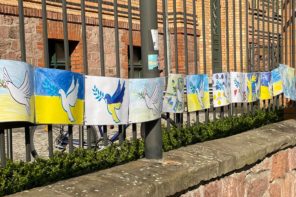Question 1: The rhetoric surrounding smugglers is packed with graphic images of violence and exploitation. What does your research indicate? Are smugglers really parasites profiting on human desperation, or, at the end of the day, do they provide a service to those on the move? How do we move the conversation Forward?
My experience researching and documenting the profiles of smugglers is directly related to my work on forced displacement. We know there are historical migratory routes between points in separate nations that reflect a demand for workers in one country, and a population capable of taking on the work in another, among other factors. Mexico and the United States have had this symbiotic relationship for generations, and it can also be seen in Southeast Asia between Myanmar, Bangladesh and Malaysia, and in the movement of workers from West Africa to North Africa and on to Europe.
While the demand for workers who take up dangerous, difficult jobs has not declined in much of the world, access to visa programmes that facilitate their safe and lawful passage has become ever more difficult. Without a lawful alternative, individuals and families in need of work have resorted to irregular migration. At the same time, the criminalisation of migration throughout the world has resulted in the narrowing of routes between two points, often funnelling migrants into the most dangerous passages, and a growing reliance on ‘experts’ who can facilitate safe passage. This phenomenon is the inevitable consequence of national and international laws that politicise and restrict freedom of movement regardless of the pressing economic, social, and political dynamics of individuals, families, and industries.
Without a doubt, some smugglers engage in terribly bad acts and take advantage of those who rely on them, including through rape, torture, kidnapping, and other types of abuse. Others are part of impoverished and persecuted communities, such as the Rohingya in Myanmar, which may financially benefit by arranging boat passages, but also provide a vital lifeline to Rohingya people. Some smugglers may do both.
Migrants often have multiple motivations for moving and the same can be said of those who take up smuggling tasks. National and international policies and responses that cast all smugglers as bloodthirsty villains distort this reality and are unlikely to lead to the dismantling of smuggling routes. Yet, these same crackdowns may further undermine the rights of people on the move. For example, Thailand’s crackdown on smuggling and trafficking in 2015 resulted in the abandonment of thousands of Rohingya people at sea. They were left at sea because the smugglers and traffickers could not meet them at traditional disembarkation points. This tragedy was foreseeable but not planned for, and the smuggling continues.
Question 2: Media, academic and policy circles suggest that human smuggling is a gateway human trafficking. Many times both terms are used interchangeably. Does your work provide any insight into these phenomena and what does that say about migration?
Particularly in the case of the Rohingya in Myanmar, the terms ‘smuggling’ and ‘trafficking’ have been used interchangeably by the media, governments, and advocates, perhaps to the detriment of the Rohingya. The Rohingya people have fled persecution and state-orchestrated ethnic cleansing for decades. In the 1970s, the Rohingya were attacked en masse and hundreds of thousands crossed into Bangladesh with little need for the assistance of smugglers because the passage was close and relatively safe.
By the early 1990s, Bangladesh had criminalised and terrified Rohingya refugees, so when new Myanmar government purges occurred, tens of thousands of Rohingya fled further afield to Thailand and Malaysia. Because the Rohingya were (and continue to be) stateless, they had no formal identification documents and needed the assistance of smugglers to pass through regions and states that required documentation to enter. The lack of any legal record certainly made them vulnerable to trafficking, and all but assured their reliance on smugglers.
In mid-2015, when the world watched unfold, but for too many Rohingya, this was not the case. Indeed, there was nothing new about the miserable boat passage for the Rohingya, except perhaps the number of people who undertook the journey in 2015. The Rohingya had been enduring life-threatening boat passages for at least ten years, and they did not need to be tricked into it. Many of the Rohingya I spoke with in Myanmar and Malaysia had expected a treacherous journey and intended to pay back the cost of their passage upon arrival in Malaysia through work that would be arranged by the smuggler. It cannot be said that they were all being trafficked, although the circumstances under which they ultimately travelled and were held may have transformed their situation into one of trafficking. Many of the Bangladeshi people on the boats likely were the victims of trafficking, but the complexity of their situation cannot be adequately addressed in this short form.
Regardless, by describing the situation of the Rohingya as trafficking rather than smuggling, governments, advocates and the media enabled Myanmar to claim that the situation on the Andaman Sea was an issue of law and order, rather than persecution and ethnic cleansing. While this assertion was ultimately challenged, the unilateral and regional responses of nations in the region focused on a law enforcement crackdown that did nothing to promote or protect the rights of the Rohingya.
Question 3: Another myth connected to smuggling is the one pertaining to its organisation. We hear of smugglers organised into cartels, networks or transnational groups, but also of small-scale operations. What does your work suggest, and what does that say about irregular migration?
My research points to the existence of a variety of actors who facilitate the movement of people. In each region of the world where I have focused, most individuals and families have moved with the assistance of brokers, smugglers, or other facilitators. Oftentimes the starting point is a respected member of the community who has relationships with relevant local officials and can secure passage for individuals through the payment of bribes or other inducements. Sometimes one smuggler arranges the journey through one country while another arranges the journey onward. In many situations, people on the move are aware that they are traveling inside of a transnational and well-established smuggling network, but they don’t know how it works, how many people are involved on any given day, or how authority is established between different actors.
Regardless of whether refugees and migrants rely on one individual or a network of smugglers to cross territories, the underlying reason for this clandestine movement is essentially the same. They have assessed their physical, social, political, and economic security, and determined that their interests/rights are more likely to be fulfilled by moving to another region or country, even without permission. Until these dynamics are addressed, refugees and migrants will continue to rely on smugglers because they have determined that access to livelihood and security compels it. The global economy is inherently contradictory and both encourages irregular migration by refusing to issue needed visas to employers and workers, and punishing migrants for their inevitable clandestine movement. Until these dynamics are addressed, smugglers small and large will continue to flourish.
See more responses here:
[circles_gallery ids=”18661,18780,18660,18844,18770,18658,18657,18717,18673,18669″]









